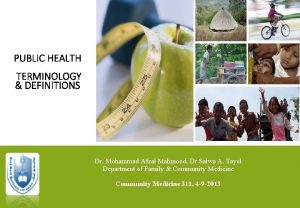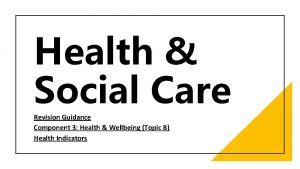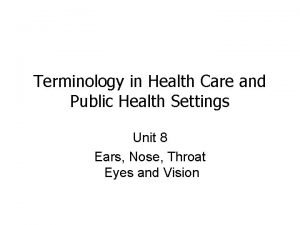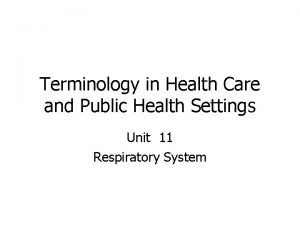Terminology in Health Care and Public Health Settings

Terminology in Health Care and Public Health Settings Unit 2 Integumentary System Component 3/Unit 2 Health IT Workforce Curriculum 1/Fall 2010 Version 1 .

Integumentary System Overview • Organs of Integumentary System – Skin – Hair – Nails – Sebaceous glands – Sweat glands Component 3/Unit 2 Health IT Workforce Curriculum 1/Fall 2010 Version 2 .

Integumentary System Overview • Covers the entire surface of the body • Functions – Protection – Houses nerve receptors – Secretes fluids – Regulate temperature Component 3/Unit 2 Health IT Workforce Curriculum 1/Fall 2010 Version 3 .

The Skin • Three layers – Epidermis – thin, outer membrane layer – Dermis – middle, fibrous connective tissue layer – Subcutaneous layer – inner most layer of fatty tissue Component 3/Unit 2 Health IT Workforce Curriculum Version 1/Fall 2010 4 .

Accessory Organs • Located within dermis • Include: – Hair – Nails – Sweat glands – Sebaceous glands Component 3/Unit 2 Health IT Workforce Curriculum 1/Fall 2010 Version 5 .

Burns • There are three types of burns: – First-degree burns damage only the outer layer of skin – Second-degree burns damage the outer layer and the layer underneath – Third-degree burns damage or destroy the deepest layer of skin and tissues underneath Component 3/Unit 2 Health IT Workforce Curriculum 1/Fall 2010 Version 6 .

Skin cancer • Most common form of cancer in the United States. – Common types are basal cell cancer and squamous cell cancer. – They usually form on the head, face, neck, hands and arms. – Another type of skin cancer, melanona, is more dangerous but less common. Component 3/Unit 2 Health IT Workforce Curriculum 1/Fall 2010 Version 7 .

Skin Cancer • Anyone can get skin cancer, but it is more common in people who – Spend a lot of time in the sun or have been sunburned – Have light-colored skin, hair and eyes – Have a family member with skin cancer – Are over age 50 Component 3/Unit 2 Health IT Workforce Curriculum 1/Fall 2010 Version 8 .

Wounds • Include cuts, scrapes, scratches and punctured skin. • Often occur as a result of an accident or injury, but surgical incisions, sutures, and stitches also cause wounds. • Minor wounds usually aren't serious, but even cuts and scrapes require care. Component 3/Unit 2 Health IT Workforce Curriculum 1/Fall 2010 Version 9 .

Common hair problems • Include hair loss, infections, and disorders causing itching and scaling. • Hair loss (alopecia) is a frequent concern for both men and women. – Male pattern baldness is the most common cause of hair loss in men, with a receding hair line and baldness on the top of the head. – Women may develop female pattern baldness in which the hair becomes thin over the entire scalp. Component 3/Unit 2 Health IT Workforce Curriculum 1/Fall 2010 Version 10 .

Common hair problems • Infections of the scalp include bacterial infection of hair follicles, infestation of head lice, and fungal infection of scalp ringworm • Itching and excessive flaking of the scalp is seen with both dandruff and psoriasis. Component 3/Unit 2 Health IT Workforce Curriculum 1/Fall 2010 Version 11 .

Problems with nails • Clue to your overall health. • Healthy nails are usually smooth and consistent in color. • Specific types of nail discoloration and changes in growth rate can signal various lung, heart, kidney and liver diseases, as well as diabetes and anemia. Component 3/Unit 2 Health IT Workforce Curriculum 1/Fall 2010 Version 12 .

Integumentary Combining Forms • • • cry/o cold cryosurgery cutane/o skin cutaneous derm/o skin dermatitis kerat/o hard, horny keratosis lip/o fat liposuction py/o pus pyogenic Component 3/Unit 2 Health IT Workforce Curriculum 1/Fall 2010 Version 13 .
- Slides: 13

























